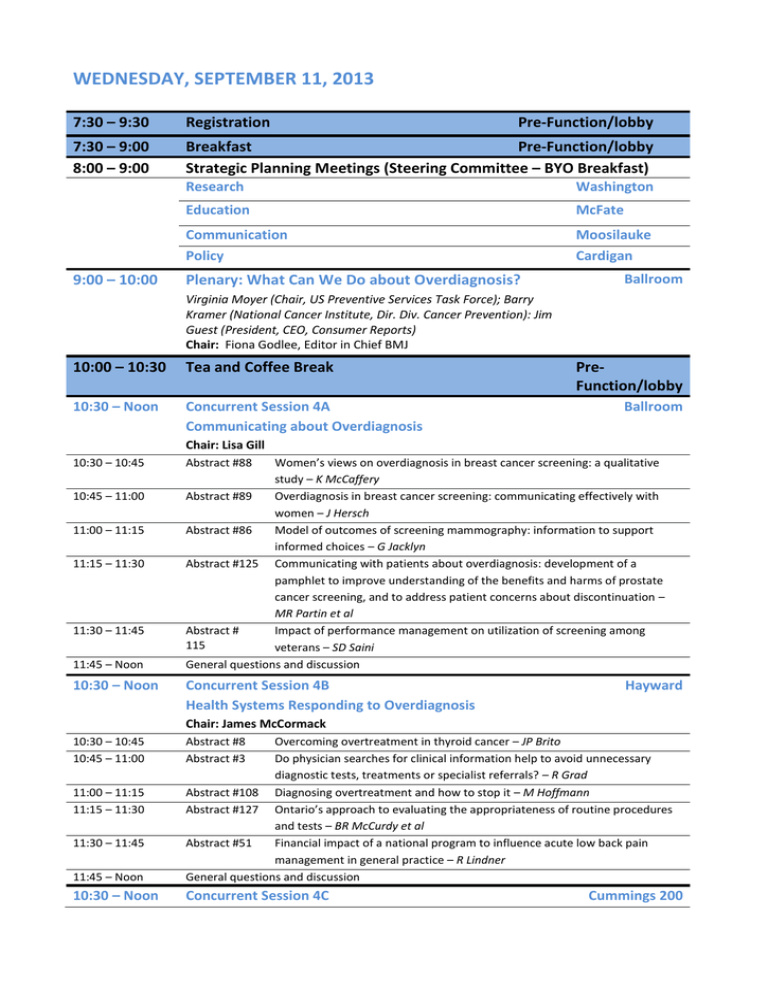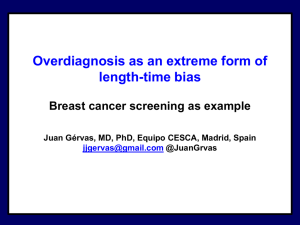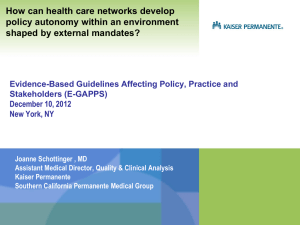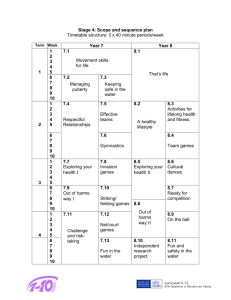10:30 Tea and Coffee Break Pre-Function/lobby
advertisement

WEDNESDAY, SEPTEMBER 11, 2013 7:30 – 9:30 Registration 7:30 – 9:00 8:00 – 9:00 Breakfast Pre-Function/lobby Strategic Planning Meetings (Steering Committee – BYO Breakfast) 9:00 – 10:00 Pre-Function/lobby Research Washington Education McFate Communication Policy Moosilauke Cardigan Plenary: What Can We Do about Overdiagnosis? Ballroom Virginia Moyer (Chair, US Preventive Services Task Force); Barry Kramer (National Cancer Institute, Dir. Div. Cancer Prevention): Jim Guest (President, CEO, Consumer Reports) Chair: Fiona Godlee, Editor in Chief BMJ 10:00 – 10:30 Tea and Coffee Break 10:30 – Noon Concurrent Session 4A Communicating about Overdiagnosis PreFunction/lobby Ballroom Chair: Lisa Gill 10:30 – 10:45 10:45 – 11:00 11:00 – 11:15 11:15 – 11:30 11:30 – 11:45 11:45 – Noon 10:30 – Noon Abstract #88 Women’s views on overdiagnosis in breast cancer screening: a qualitative study – K McCaffery Abstract #89 Overdiagnosis in breast cancer screening: communicating effectively with women – J Hersch Abstract #86 Model of outcomes of screening mammography: information to support informed choices – G Jacklyn Abstract #125 Communicating with patients about overdiagnosis: development of a pamphlet to improve understanding of the benefits and harms of prostate cancer screening, and to address patient concerns about discontinuation – MR Partin et al Abstract # Impact of performance management on utilization of screening among 115 veterans – SD Saini General questions and discussion Concurrent Session 4B Health Systems Responding to Overdiagnosis Hayward Chair: James McCormack 10:30 – 10:45 10:45 – 11:00 11:45 – Noon Overcoming overtreatment in thyroid cancer – JP Brito Do physician searches for clinical information help to avoid unnecessary diagnostic tests, treatments or specialist referrals? – R Grad Abstract #108 Diagnosing overtreatment and how to stop it – M Hoffmann Abstract #127 Ontario’s approach to evaluating the appropriateness of routine procedures and tests – BR McCurdy et al Abstract #51 Financial impact of a national program to influence acute low back pain management in general practice – R Lindner General questions and discussion 10:30 – Noon Concurrent Session 4C 11:00 – 11:15 11:15 – 11:30 11:30 – 11:45 Abstract #8 Abstract #3 Cummings 200 Preventing Overtesting and Overtreatment – Initiatives Thayer School Chair: David Henry 10:30 – 10:45 10:45 – 11:00 11:00 – 11:15 11:15 – 11:30 11:30 – 11:45 11:45 – Noon Abstract #136 ‘Goldilocks’ cancer screening – not too little ... not too much – A ComptonPhillips; L Radler Abstract #137 Success in appropriate diagnosis and management of lower back pain – F Alamshaw et al Abstract #65 Clinical review and audit – a commissioner’s approach to managing unwarranted variations in rates of abdominal hysterectomy – A Bentley Abstract #75 Veterans health administration activities to reduce overuse of cancer screening tests – LS Kinsinger Abstract #122 Review of performance measurement as an approach to targeting overdiagnosis: high yield prospects for measure development – D Pamnani et al General questions and discussion 10:30 – Noon Concurrent Session 4D Workshop – Screening: Promoting Awareness of Harms Ford Sayre/Brewster Abstract #159 Promoting awareness of the potential harms of screening: an approach to reducing overuse and overdiagnosis Presenters: R Harris, MD, MPH; C Barclay, MPH; and S Sheridan, MD, MPH. Presenters have been leaders or organizers of workshops on: research methods and preventive care (UNC MD-MPH Program); communicating benefits and harms of screening (SGIM); critical appraisal of medical literature (UNC medical students and residents); and, appropriate use of clinical preventive services (UNC Research Center for Excellence in Clinical Preventive Services). Background: One approach to increasing awareness of overdiagnosis emphasizes the financial cost of intensive testing and screening. The public, however, is skeptical about reducing even lowvalue testing “simply to save money.” An alternative approach, focusing on how intensive testing and screening exposes people to unnecessary harms, has been impeded by the lack of a clear understanding and taxonomy of these potential harms, and of a robust literature exploring them. Aims and Content: In the first hour, three 10-minute presentations will each address a workshop objective, followed by 10 minutes of discussion. 1) 2) 3) Propose a taxonomy of the potential harms of screening (including overdiagnosis): a new way of organizing our thinking about harms Summarize findings of a literature review on the published evidence about potential harms of screening, including gaps in the evidence Present ideas for a collaborative action plan to increase awareness of the potential harms of screening among several audiences In the second hour, break-out groups will meet for 30 minutes, with each beginning to outline an action plan to increase harms awareness among a target audience: 1) the public, 2) healthcare professionals, 3) policymakers, and 4) the media. The focus will be on concrete first steps that participants can make in their communities, with an eye toward collaboration and synthesis of these efforts at future meetings. We will then reconvene for a half hour of discussion about ideas from the small groups. 10:30 – Noon Concurrent Session 4E Workshop – Preventing Overdiagnosis and Back Pain Abstract #160 Preventing overdiagnosis of back pain Drake T Corbin; A Indahl; J Lurie; J Rainville Back pain is the largest cause of disability in the United States for working-age consumers and the second largest cause of physician office visits[1]. The general category of low back pain is a complex mishmash of various conditions that produce pain in the back and/or radiating into the legs. When a patient presents at a primary care office with a new complaint of pure back pain, the prognosis for a quick recovery is good. The primary indicators of potential chronicity causing extended disability are psychosocial rather than physical signs[2]. These low-risk patients are easily identified in a brief physician visit. Clinicians who consult with these patients have an obligation to educate and support patients without increasing their concerns. Although additional diagnostic tests such as MRI appear to be harmless, in fact the discussion of normal aging signs often raises concerns rather than reassures patients[3]. Any discussion of back injury with these patients is inappropriate because in most cases, back pain cannot be attributed to a specific event[4], but is more likely a hereditary factor[5]. If the patient prognosis can be modified by the physician for better or worse, what should they say to alleviate concerns without appearing to minimize the patient’s complaint? In this workshop, leading back pain researchers will present the scientific evidence that back pain often has a favorable prognosis without diagnostic tests or therapy. They will share their individual strategies for brief discussions with back pain patients that maximize their chances of quick, recovery. The cost effectiveness of this approach will be discussed and extrapolated to the savings on a national level that would accrue if back pain is not overdiagnosed. 1. 2. 3. 4. Martin BI, Deyo RA, Mirza SK, et al. Expenditures and health status among adults with back and neck problems. JAMA 2008;299:656–64. Hill JC, Dunn KM, Lewis M, et al. A primary care back pain screening tool: identifying patient subgroups for initial treatment. Arthritis Rheum 2008; 59: 632–41. Chou R, Fu R, Carrino JA, Deyo RA. Imaging strategies for low back pain: systematic review and meta-analysis. Lancet 2009; 373: 463–72. Carragee E, Alamin T, Cheng I, Franklin T, van den HE, Hurwitz E. Are first-time episodes of serious LBP associated with new MRI findings? Battie MC, Videman T, Levalahti E, Gill K, Kaprio J. Heritability of low back pain and the role of disc degeneration. Pain 2007; 131: 272–80. Noon – 1:15 Lunch Pre-function/lobby Noon – 1:15 Poster Session B with Poster Presenters Lower Pre-function 1:15 – 2:45 Concurrent Session 5A Communicating about Overdiagnosis with Patients/Citizens Ballroom Chair: Kirsten McCaffery 1:15 – 1:30 2:30 – 2:45 Cancer screening recommendations of the USPSTF: the impact of overdiagnosis on estimating benefits and harms – TJ Wilt Abstract #118 Use of a prostate cancer screening patient decision aid reduces patient intent to be screened – CD Brackett Abstract #53 Using a discrete choice experiment to communicate overdiagnosis in PSA screening – MP Pignone Abstract #116 How do citizens balance the benefits and burdens of newborn screening? A public engagement survey – F Miller Abstract #149 Terrorized by the polyp police: How well are consumers informed about the benefits and harms of colonoscopies and the uncertainties around colon polyps? – A Cassels; W Armstrong General questions and discussion 1:15 – 2:45 Concurrent Session 5B 1:30 – 1:45 1:45 – 2:00 2:00 – 2:15 2:15 – 2:30 Abstract #46 Hayward Initiatives to Prevent Overdiagnosis Chair: Tessa Richards 1:15 – 1:30 1:30 – 1:45 1:45 – 2:00 2:00 – 2:15 2:15 – 2:30 2:30 – 2:45 1:15 – 2:45 Abstract #83 Overdiagnosis.org: an evidence-based resource for patients and clinicians – M Kadoch Abstract #72 Professional societies’ top 5 lists for the choosing wisely initiative: evidencebased and sustainable? R Harris Abstract #16 Attending to our first obligation: the Do No Harm Project – B Combs Abstract #14 The first International Days on Medical Independence (IDMI) – P de Chazournes; A Cassels Abstract #37 Education – back to clinical thinking – R Rahmani General questions and discussion Concurrent Session 5C Policies and Interventions to Reduce Overdiagnosis Cummings 200 Thayer School Chair: Ray Moynihan 1:15 – 1:30 1:30 – 1:45 1:45 – 2:00 2:00 – 2:15 2:15 – 2:30 2:30 – 2:45 Abstract #4 Reducing overdiagnosis by eliciting patients’ preferences about acceptable regret of diagnostic testing – B Djulbegovic Abstract #11 Analysis of clinical trial data by using evidence-based triage reduces overdiagnosis – D Llewelyn Abstract #43 Proscribing hospital sponsorship of low-value testing by direct-to-consumer screening companies: a call to action – E Wallace Abstract #60 Diagnosing and preventing overdiagnosis in Germany – D Klemperer Abstract # Child health supervision: Too many visits? Too much empty ritual – GE 139 Harkless General questions and discussion 1:15 – 2:45 Concurrent Session 5D Workshop – Preventing Overdiagnosis in Emergency Department: PE as Example Abstract #123 Preventing overdiagnosis in the Emergency Department: Lessons learned from the evaluation of patients with suspected pulmonary embolism CR Carpenter; JD Schuur, AS Raja Drake Pulmonary embolism (PE) mortality has remained steady for decades despite an increasing use of testing, mainly computerized tomography (CT). This increase has been associated with overdiagnosis of clinically inconsequential PEs. CT-related risks include contrast-induced nephropathy and long-term cancer risks related to radiation exposure. Despite a growing recognition of the risks associated with our current diagnostic and treatment paradigm, the number of PE CTs continues to increase each year in the United States. This workshop will review the reasons for overdiagnosis of PE and potential approaches to change this paradigm. Over 60-minutes, this workshop aims to use PE evaluation in the emergency department (ED) as a case study for changing practices resulting in overdiagnosis in a stressful and highly variable clinical area. Panelists will present the 10-minute topics discussed below, followed by three concurrent 20-minute breakout groups, each focused on one aspect of reducing overdiagnosis in the ED: improving evidence uptake, use of technology, or use of policy. Each subgroup will then summarize their conclusions. Dr. Carpenter will review the epidemiology and etiology of increased ED PE testing rates with an emphasis on CT, based upon his work developing an ongoing series in the leading peerreviewed journal for emergency medicine. Dr. Schuur will discuss system and policy efforts to reduce testing for PE based upon his work leading a CT appropriateness project across the 7 EDs of Partners Healthcare. He will share methods, challenges and successes from this effort. He has previously spoken nationally on quality measures with his work group’s guideline for appropriate testing endorsed by the National Quality Forum. Dr. Raja will discuss innovative strategies to change physician behavior using electronic decision support and accountability tools. He will use his NIH-funded work as actionable and pragmatic approaches for these challenges. Concurrent Session 5E Workshop – Interactive: How Should We Define Disease? Abstract #39 Ford Sayre/Brewster Preventing overdiagnosis: ethical and philosophical considerations WA Rogers*, J Doust#, P Glasziou# *Macquarie University, Sydney, NSW, Australia # Bond University, NSW, Australia Introduction One of the barriers to preventing overdiagnosis is that there are no agreed criteria for defining disease. Without criteria for defining disease, it is difficult to claim that overdiagnosis is occurring. For example, the claim that chronic kidney disease (CKD) is overdiagnosed relies on assumptions about what a disease is, and the ways in which CKD maps onto these assumptions. The history of disease definition recognizes two broad approaches. The first is naturalist, in which disease is defined in terms of objective or measurable departures from norms of species functioning. The second is normative, in which disease is defined in terms of states that are more or less disvalued by society. Both approaches have strengths and weaknesses, and neither seems wholly correct. Aims and methods The aim of this workshop is to investigate how we should define disease. Should we rely upon pathology or other apparently objective measures? If so, what is the “normal” against which these should be calibrated, given that increasingly sophisticated tests have broken down the distinction between normal and pathological? What weight, if any, should we give to the harms that ensue from particular physical or mental states, when defining disease? In the first part of the workshop, Rogers will present various criteria used in the definition of disease, including departures from normal species functioning, statistical definitions, observable pathology, individual and social disutility and so forth. The second part of the workshop will comprise two case studies, one on CKD by Doust, and one on prostate cancer by Glasziou. The case studies will examine how CKD and prostate cancer fit or do not fit with various criteria for defining disease. We will use the case studies to examine questions such as determining the reference population for “normal,” whether apparently harmless abnormalities should count as disease; and whether or not the definition should alter depending upon the availability of beneficial remedies. Format Introduction and background to defining disease (W Rogers, 20 min, including discussion) Case study 1: CKD (J Doust, 25 min, including group discussion) Case study 2: Prostate cancer (P Glasziou, 25 min, including group discussion) General discussion and wrap up (All, 20 min) Potential outcomes Potential outcomes include: a) Discussion about what a definition of disease ought to be able to tell us; b) Potential criteria for defining disease and justifications for these; and greater clarity about the extent to which the definition of disease plays a key role in overdiagnosis. 2:45 – 3:00 Tea and Coffee Break 2:45 – 4:00 From 3:00 on Information/Registration Desk Open Self-guided Walking Tours of Dartmouth Campus Dinner on your own Pre-function/lobby




